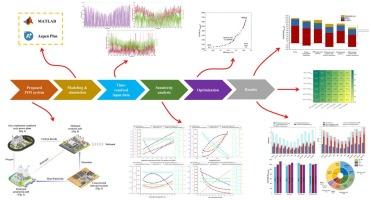e-甲醇生产与氧燃料发电厂集成的技术经济优化:澳大利亚适应性电力管理案例研究
IF 10.9
1区 工程技术
Q1 ENERGY & FUELS
引用次数: 0
摘要
能源和化学部门脱碳的迫切需要需要创新的途径,将可再生能源与碳利用结合起来。本研究提出了一种新的电能制甲醇(PtM)系统。它独特地结合了太阳能驱动的氢供应,通过热化学方法,与电力市场挂钩的灵活操作,以及详细的技术经济模型,将其与之前的电子甲醇集成研究区分开来。甲醇合成装置使用的二氧化碳来自改造后的全氧燃料发电厂。在评估的配置中,最佳方案的捕集率为350.1 kgCO2/MWh,相关效率损失为6.7%。尽管有这些有前途的特性,但单独的碳捕获方法产生的二氧化碳避免成本很高,为217.4美元/吨二氧化碳,从经济上讲是不可行的。本研究探讨了将捕获的二氧化碳转化为甲醇以提高经济可行性,从而为采用先进的捕集技术创造经济激励。详细的商业规模模块化e-甲醇生产装置(750吨甲醇/天)提出。该系统动态运行,适应电力市场波动,通过灵活的电网交互提高经济效益。所需的氢和氧通过太阳能驱动的铜氯(Cu-Cl)热化学循环提供。多目标优化确定了最优设计,实现了甲醇平准化成本(LCOM)为1190美元/tMeOH,整体效率为11.8%,特定二氧化碳排放量为1.2 tCO2/tMeOH。生产的e-甲醇与灰色甲醇仍然没有竞争力。然而,对2050年的未来预测表明,在预期的二氧化碳奖励计划和关键成本部分的减少下,最低成本可能大幅下降到745美元/吨meoh。本文章由计算机程序翻译,如有差异,请以英文原文为准。

Techno-economic optimization of e-methanol production integrated with oxy-fuel power plants: an adaptive power management case study in Australia
The urgent need to decarbonize the energy and chemical sectors necessitates innovative pathways that integrate renewable energy with carbon utilization. This study presents a novel Power-to-Methanol (PtM) system. It uniquely combines solar-driven hydrogen supply via a thermochemical method, flexible operation tied to electricity markets, and detailed techno-economic modelling, distinguishing it from previous e-methanol integration research. The CO2 utilized in the methanol synthesis unit is sourced from a retrofitted oxy-fuel power plant. Among the evaluated configurations, the best option achieves a capture rate of 350.1 kgCO2/MWh, with an associated efficiency penalty of 6.7%. Despite these promising features, the standalone carbon capture approach yields a high CO2 avoidance cost of $217.4/tCO2, making it economically unviable. This study investigates the conversion of captured CO2 into methanol to improve economic feasibility, thereby creating financial incentives for the adoption of advanced capture technologies. A detailed commercial-scale modular e-methanol production unit (750 tMeOH/day) is presented. The system operates dynamically, adapting to fluctuations in electricity markets to improve economic returns through flexible grid interaction. Required hydrogen and oxygen are supplied via a solar-driven Copper–Chlorine (Cu–Cl) thermochemical cycle. Multi-objective optimization identifies the optimal design, achieving a Levelized Cost of Methanol (LCOM) of $1,190/tMeOH, an overall efficiency of 11.8%, and a specific avoided CO2 of 1.2 tCO2/tMeOH. The produced e-methanol remains non-competitive with grey methanol. However, future projections for 2050 indicate that, under anticipated CO2 incentive schemes and reductions in critical cost components, the LCOM could decrease significantly to $745/tMeOH.
求助全文
通过发布文献求助,成功后即可免费获取论文全文。
去求助
来源期刊

Energy Conversion and Management
工程技术-力学
CiteScore
19.00
自引率
11.50%
发文量
1304
审稿时长
17 days
期刊介绍:
The journal Energy Conversion and Management provides a forum for publishing original contributions and comprehensive technical review articles of interdisciplinary and original research on all important energy topics.
The topics considered include energy generation, utilization, conversion, storage, transmission, conservation, management and sustainability. These topics typically involve various types of energy such as mechanical, thermal, nuclear, chemical, electromagnetic, magnetic and electric. These energy types cover all known energy resources, including renewable resources (e.g., solar, bio, hydro, wind, geothermal and ocean energy), fossil fuels and nuclear resources.
 求助内容:
求助内容: 应助结果提醒方式:
应助结果提醒方式:


